Often enchanted by the bright light that spreads over the whole country and the white hue of the buildings that climb the hill, nicknamed “Alger la Blanche”, a name that could not be better suited to this large lively city, that looks towards the Mediterranean and turns its back on the desert, between Morocco and Tunisia. Capital of one of the largest and richest countries in Africa, Algiers has one of the largest ports on the whole continent. With more than three million inhabitants, the city is divided into two zones: one modern, sunk on the coast, the other old, the Casbah, the old medina, perched on top of a hill, at 490 feet of altitude. If you ever decide to come and visit this beautiful city, here are the must-do things you must do:
1- The Martyr’s Memorial, A beautiful site of national memory.
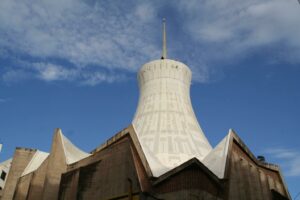
We begin our visit with the memorial of the Martyr or Maqam Echahid, one of the most visited famous monuments in Algiers, Built-in 1982 near the Hamma Test Garden on the occasion of the 20th anniversary of the independence. It is dedicated to the veterans of the Algerian War. It consists of three stylized palms that meet at mid-height, entirely in concrete. Beneath the monument is the Mujahid National Museum. A beautiful panorama of the bay and the southern districts is offered to you from the balustrade at the top of the Omar Kechkar path. This monument is of great importance to the Algerian people, it is considered the protector of the city of Algiers In addition, if you take the route of the sanctuary, it is an adventure in itself, with breathtaking views, roads through parts of mountains, and such an impressive natural beauty that will not leave you indifferent. Once there, you cannot help but stop and gaze at this fabulous monument for long minutes. It is a place to visit absolutely during your visit to our capital!
2- Casbah
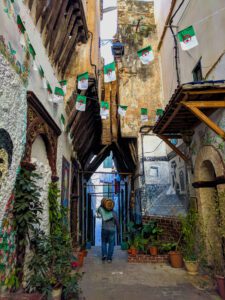
Kasbah means “castle”. This is the historic district of Algiers, including the Old Town, a UNESCO World Heritage Site. You can walk through the maze of alleys between the houses, which sometimes hide hidden treasures. It is at the Kasbah that you will discover the most beautiful mosques in the city. La Kasbah is surrounded by a castle built in the 16th century. Medersas (schools) and mausoleums will be at the center of your visit. You can easily spend a day there.
3- The pala
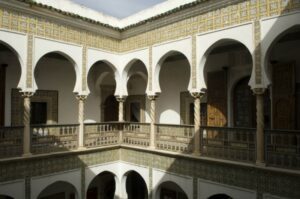
Still, in Kasbah, Dar Aziza is a palace located on Martyrs Square. Located across from the Kechaoua Mosque, it is typical of 16th-century Algerian houses. It was once the residence of the Regent of Algiers. Although it is officially closed to the public, access to its courses is sometimes possible depending on the goodwill of the guard. There are two versions of the history of this beautiful house. The most popular saying is that Dar Aziza was founded in the 16th century on the orders of his daughter Aziza, who gave his hand to the Bey of Constantine. Henri Klein reported these facts without specifying the names of the sovereign states involved or the exact dates of these events. Another more precise version, reported by Eugène Vayssettes, says that Aziza, daughter of the caïd Ahmed Ben Ramdane and sister of Chelebi Ben Ali Bitchine, first married the bey Mohammed ben Ferhat of Constantine, and after this man’s death, she returned to her brother Rajab Bey. She loved him so much that she took him to Algiers, where they celebrated a great wedding. For her, he built a palace that later became a secondary residence for the Constantine family when they went to Algiers to pay their taxes. Jenina Palace is the oldest palace in Algiers. It was the center of power until 1817. Destroyed by a fire in 1844, only parts remain, including Dar Aziza.
4- The Hamma District Test Garden
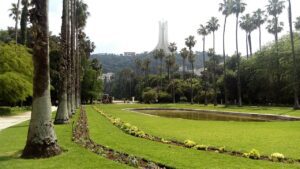
5- The Basilica of Algiers: Our Lady of Africa
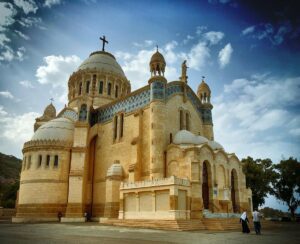
After fourteen years of work, the cathedral was completed in 1872. The architect Jean Eugène Fromageau built it according to a Byzantine plan and covered it with a dome. His plan has the distinction of positioning the choir to the southwest (rather than to the usual east). It is built on a 124 m promontory north of Algiers overlooking the sea and accessible by cable car from Bologhine (former Saint Eugene). Overlooking the Gulf of Algiers, this impressive Roman Catholic church stands on a cliff at an altitude of around 125 meters. Built-in the 19th century, its French architect (Jean-Eugène Fromageau) adopted it over time in France. She is considered the “twin sister” of the Church of Our Lady of Marseille. Masses are held every day in French, but many tourists come here just to admire the beautiful architecture and the views.”
6- The National Museum of Fine Arts
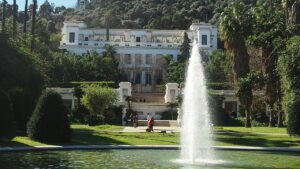
7- The Cathedral of the Sacred Heart of Algiers

Coeur cathedral is known for its modernist architecture. It was built in 1962 to meet the wishes of Bishop Leynaud in 1944 and Bishop Duval in 1958. Built according to the plans of Paul Herbé and Jean Le Couteur, it replaced Saint-Philippe Cathedral, which took over the Muslim cult at independence. The hyperbolic ‘tower’ peaks at 35m. The inside is amazing. Above the “dome” is a rose window that rests on four concrete arches supported by eight columns. The play of lines and the use of concrete perfectly represent the concept of God’s tent in the Gospel of St. John conceived by architects Paul Herbe and John Lecourt. These carpets were given by Louis Philippe to the Basilica of Saint Philippe. The Berber boxes were given to the cathedral by the Tiberium monks eleven days before their abduction and murder. The 6-ton Carrara marble altar houses the relics of African saints Victor and Falkins. The podium was a gift from Napoleon III, and the duo belonged to Stauelli’s Trappists. The authentic marble columns come from the church of Tamentfoust. Behind the nave, mosaics dating back to 324 come from the first cathedral of Castrum Tingitanum (Chlef, exOrléansville). It is a unique piece of ancient Christian art, as it will be the oldest representation of a church in the shape of a labyrinth. The organ was a gift from the diocese of Buffalick. The stained glass window is the masterpiece of master glassmaker Henri Martin Granel.
8- National Bardo Museum

9- The mosques of the Casbah
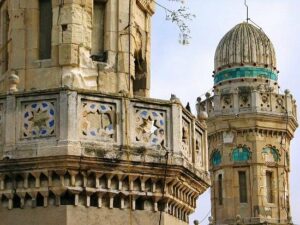
10-Palais des Rais
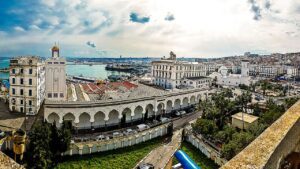
The history of the palace began with the construction of Bordj-Ez-zoubia by Dey Ramdhan Pacha in 1576 to strengthen the defenses of the lower medina. It is named QuaâEssour (lower part of the ramparts), Sebasa tbaren (seven taverns), and Topanet Arnaout because of the artillery erected by the rais Mami Arnaout. Fort 23 takes its name from the construction of the walls of the French city. On the other hand, the numbering of the designated palaces (Palace No. 16, Palace No. 17, etc.) and the houses of the “fishermen” are cadastral assignments of the same period. Bastion 23 has been well renovated and easy to visit



